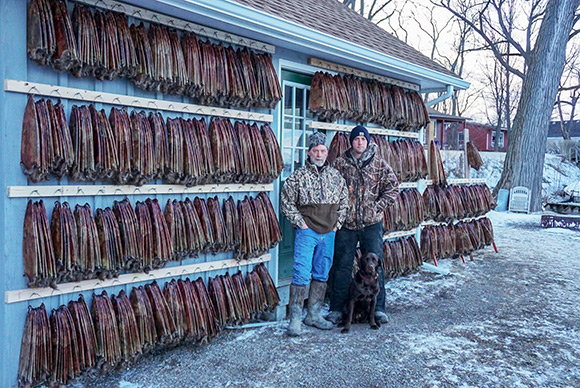 Team Fur News - June 2023
Team Fur News - June 2023
An Editor's Turkey Tale
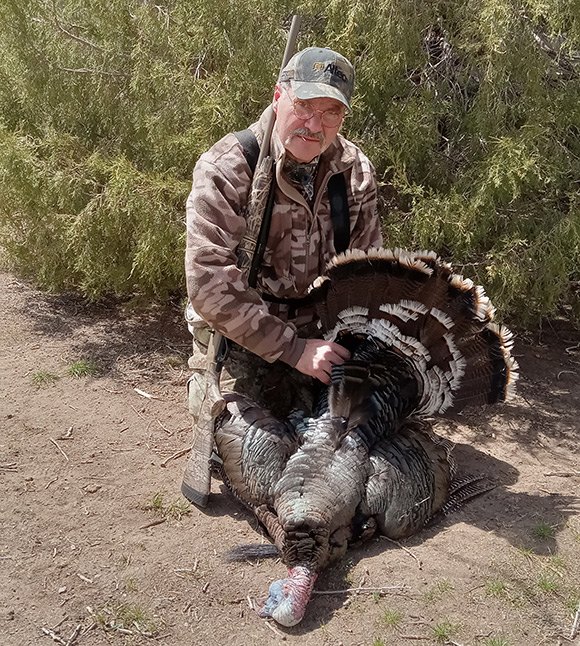
New FUR-FISH-GAME editor John D. Taylor with the Nebraska gobbler.
Confession: I’m nuts about spring gobbler hunting, a passion I owe largely to my friend and turkey hunting mentor, wildlife artist Denny Burkhart, of Wrightsville, Pennsylvania. You can find Denny’s work in Bass Pro Shops murals. He loves to hunt those crazy Eastern turkeys, and had he not taken me under his wing in the early 2000s, I’d probably not hunt turkeys. But he did, and the results validate his admonition – “If you can (successfully) hunt turkeys, you can hunt anything” – a truth that regularly puts pronghorn, elk and mule deer in my freezer.
We met in the mid-1980s when I interviewed him for my outdoor newspaper column. We shared a love of ruffed grouse hunting and bird dogs, an interest that led to Michigan’s Upper Peninsula, where banker Barry Franciscus, Ruffed Grouse Society Regional Representative Bill Goudy and Denny introduced me to their true passion: woodcock. I’ll never forget standing in an aspen and alder cutover, watching flight woodcock pitch into the goldenrod under October’s shimmering full moon.
I almost quit turkey hunting twice – despite Pennsylvania’s rising 1990s turkey populations, because I didn’t understand the birds. It seemed like an exercise in frustration. And I wasn’t copasetic with the people I tried turkey hunting with. My patience level – like those two buzzards perched on a limb, “Patience my rump, I’m gonna kill something…” — didn’t help. Why sit and wait. Go to the game.
When Denny suggested I hunt turkeys with him in the early 2000s, the apprentice found a master. We chased gobblers in Tioga County, Pennsylvania that first spring.
One bird trundled in where I couldn’t see him. Others hung up with hens. I almost tagged a big old tom in mid-May. We’d tried to corral this bird in two set-ups, but the gobbler refused – until Denny positioned me along the edge of an alfalfa field while he called, moving back and forth out of the gobbler’s sight, like a confused hen.
I shook with excitement watching that tom strut across the field toward me, but my shot was off, resulting in a flushed turkey, four black feathers on green alfalfa. I felt horrible. Denny worked so hard to make it happen.
That fall, Denny and I slipped close to a roost before dawn, listened to a flock of turkeys awaken, and watched a group of jakes fly down towards his calling. One of those jakes flopped on the leaves at my shot. I’ve never seen Denny more excited that I’d finally bagged a turkey.
That spring, I called up and tagged a nice gobbler on my own. Denny heard the story before my wife Nancy did.
The hook was set. Since then, I’ve been fervently chasing spring gobblers, especially the Merriam’s subspecies that roam the Dakotas and Nebraska. I think of Denny, all the things he taught me, every spring.
In late April this year, I tried a new Nebraska spot. An hour before sunset, I spotted a gobbler with two hens, followed them until dark. Their exact roost was a mystery, but I was confident. That night in Taylor’s Turkey Motel (the back of my Ford Expedition), I planned my approach.
Next morning, I slipped into their “bedroom,” sat my gun up 50 yards from the tom’s muffled gobbles. It was 31 degrees, and my fingertips went numb from frostbite accrued tending horses in a 56-below Wyoming blizzard that winter. Yet I was certain I’d tag the tom when they flew down.
Something (not me or other hunters) spooked those birds, set them flying. I followed them across several canyons that morning but simply couldn’t get in front.
Plan B was blind calling to locate another gobbler – with no responses – in another canyon. When I stood to leave, binoculars revealed a dandy tom with a hen 200 yards up the canyon, traveling in my direction, the hen eating cold grasshoppers in the bluestem.
She made for long odds, but I sat back down, gun up, under a cedar with a good view of the canyon bottom and called again. The tom gobbled twice but remained distant, so I tried Denny’s “shut up and see what happens” technique. Some cut brush blocked my view of the last part of the canyon, but it wasn’t long before the tom appeared. He’d puff up, strut, look for the hen he heard, walk a few steps, repeat. He might have expected the silent hen in the strut zone behind me.
At 40 yards, my Winchester SX4 autoloader barked.
That tom wore a 10-inch beard and inch long spurs, a dandy Nebraska Merriam’s. Thank you again, Denny.
Alabama Free Fishing Day June 10
-15.jpg)
Two Alabama anglers fishing from a boat, courtesy Alabama Department of
Conservation and Natural Resources
Alabama is hosting a free fishing day on most public waters, both fresh and saltwater, on Saturday, June 10. Free Fishing Day allows residents and non-residents to enjoy the outstanding fishing Alabama has to offer without purchasing a fishing license. Free Fishing Day also takes place during Alabama’s red snapper season. While fishing license requirements are waived for Free Fishing Day, those fishing for red snapper will still need a $10 Gulf Reef Fish Endorsement. Also, state Public Fishing Lakes still require a fishing permit on Free Fishing Day, and fishing in a private pond requires the pond owner’s permission. Some piers may also require fees and permits. Anglers looking for a new public fishing spot are encouraged to explore the fishing section of www.outdooralabama.com.
Maine Hiking Reminders
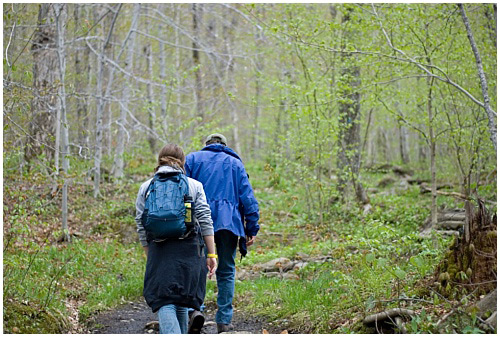
Hiking is a great way to exercise and take in nature's wonders, but it never hurts to keep
these safety tips in mind, courtesy of Maine Wardens Service.
As the days grow warmer, and people spend more time outside, hiking is an ideal way to get some fresh air, exercise and soak up picturesque views. Following an increased number of lost hiker searches in recent years, the Maine Warden Service wants to educate hikers to ensure people enjoy their time outdoors, while staying safe, and being prepared. Some hiking reminders include:
• Tell someone where you’re going and when you plan to return. Should something happen, this is key to helping the Warden Service find you.
• Conditions can vary significantly across the state and at different elevations, especially in spring, when the bottom of a mountain trailhead can look inviting, but higher elevations can still be covered in ice and snow. A coastal mountain of the same elevation may be ready to hike weeks before a mountain in the north.
• Hike at your experience level. Research your destination before you go. Always respect closed trail signs. They’re there for a reason. Know before you go.
• Many roads to Maine hiking areas are dirt and can be extremely muddy, even impassable, during spring.
• Respect private land. More than 94% of Maine’s forest land is privately owned.
• Be a good land user, keep the trials clean, don’t block paths, gates or roads when you park. Always leave the land as you found it, if not better. Pick up trash, even if you didn’t leave it.
• Dress for the weather, in layers and wear hiking shoes. Also, be prepared for changing weather conditions and no cell phone service. Know your route without cell phone help.
• Pack essential items – water, high-protein snacks, a fire starter – that can prepare you for a night in the woods, should anything happen.
• Stick to established trails and roads. Always stay on the trail. And plan your day, know how long the hike may take, and plan accordingly.
• Have a Plan B. If the trailhead is full, have an option. Consider adventuring during the week, or for shorter hikes. Avoid peak hours.
Visit mefishwildlife.com/outdoorpartners or visitmaine.com/look-out-for-me
Wildlife agencies say let youngsters alone
.jpg)
Fawns are being born now and should be left alone. Their mothers are almost always nearby. VTF&Wphoto/Sean Fowler.
Both the Oklahoma Department of Wildlife Conservation and the Vermont Fish and Wildlife Department are urging people not to “rescue” young wildlife. Simply leave them be, let their mothers take care of them. Most deer fawns are born in late May and early June, says Vermont deer biologist Nick Fortin. People should keep their distance and avoid disturbing the fawn if one is discovered, because the fawn’s mother is almost always nearby, Fortin says. Deer nurse their young at different times during the day, often leaving the fawn alone for long periods of time. The fawn is not lost, the doe knows where it is and will return. Deer normally won’t feed or care for their young if people are nearby. Bringing a fawn into a human environment usually results in a sad ending for the animal. Mark Howery, Wildlife Diversity Senior Biologist in Oklahoma, agrees. Springtime means newborn birds, rabbits, squirrels, deer and most every other critter in his state. His message is also to simply leave young wildlife alone. “Well-meaning people often misinterpret normal wildlife behavior as something abnormal, and it usually does more harm than good when people intervene,” Howery said. Oklahoma fawns are also born in May and early June. They’re safest when left alone. Their color pattern helps them remain undetected. Does visit their fawns to nurse infrequently, a behavior that helps fawns avoid detection by predators. Also, newborn birds or fledglings might look helpless, but they don’t need assistance unless they have clear signs of injury, like a broken wing. Rabbits and other young mammals are visited by their mother only a few times a day to avoid attracting predators to the young. The young of all species are generally safe when left alone. Visit https://www.wildlifedepartment.com/wildlife/leave-young-wildlife-alone
COVID Confirmed in Calif. Mule Deer
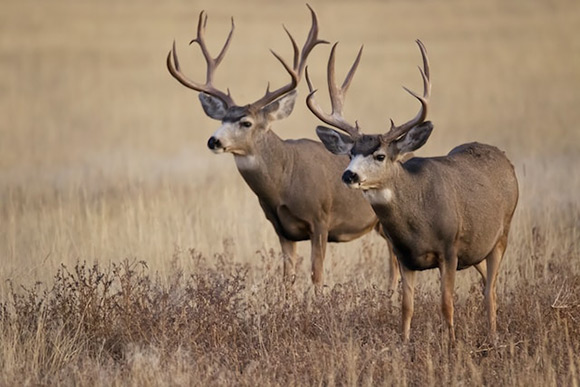
Two muley bucks, courtesy Unsplash/Acton Crawford.
The virus that causes COVID-19, SARS-CoV-2, has been detected for the first time in free-ranging California wildlife. A hunter-harvested mule deer, a buck from El Dorado County, was confirmed to be infected with the virus. The deer was harvested in 2021 and sampled by the California Department of Fish and Wildlife (CDFW) for chronic wasting disease (CWD). It was negative for CWD and did not show any outward signs of illness. Following reports of the virus detected in free-ranging whitetails and mule deer in other states and Canadian provinces, CDFW tested archived deer samples for SARS-CoV-2. The samples were lymph nodes collected as CWD surveillance. CWD has never been detected in California’s deer or elk populations. However, SARS-CoV-2 had been confirmed in pets and zoo animals, but never in free-ranging wildlife – until this deer. Dr. Brandon Munk, senior CDFW wildlife veterinarian, says the virus is not a threat to California deer populations, but CDFW will continue to work to better understand what significance SARS-CoV-2 infections in wildlife may pose to wildlife and people. CDFW urges people not to intentionally feed deer because artificially congregating deer in an area increases the likelihood of spreading diseases. There is no evidence that people can contract COVID-19 by eating meat from an infected animal. However, hunters are encouraged to take appropriate precautions when handling and dressing game and practice good food hygiene when processing their animals.
Traveling trees
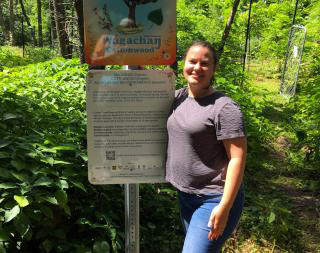
Forest Service climate adaptation specialist Leslie Brandt stands in front of an adaptive silviculture site planted with cottonwood seedlings from trees adapted to warmer climate conditions. Her team is assessing if these trees are more resilient to the changing climate conditions there. Courtesy, Leslie Brandt.
Tree species “migrate” in their own way, taking decades, even centuries, for small movements. “Natural migration is very slow for most tree species,” said Leslie Brandt, a U.S. Forest Service climate adaptation specialist. So, what happens when climate change begins to impact forests? Trees can't disperse their seeds very far; and natural migration may not keep up with the rapid pace of climate change. This could mean whole forests dying off, even landscape scale impacts. If native trees can’t fill the space, invasive tree species may take over. Or, the ecosystem could rapidly change, from hardwood to pine forest, or from pine forest to prairie. Such dramatic changes would cause harm to wildlife and the humans who rely on forest resources. That’s where “assisted tree migration” comes into play. Assisted migration is the human-assisted movement of trees in response to climate change. There are two types of assisted migration: Assisted population migration involves moving trees to new locations within a species’ established range, typically as a seeds or seedlings. Researchers collect seeds from trees of the same species in a slightly lower elevation or latitude with different genetic material that makes the moved trees capable of adapting to warmer conditions. Assisted range expansion is tree movement from their current range to suitable areas beyond their current range. For example, when a forested area in Saint Paul, Minnesota, suffered extensive canopy loss from the emerald ash borer, an invasive insect that has caused considerable damage to ash trees, invasive grasses and herbs took over outcompeting native trees. This resulted in significant wildlife impacts. To reestablish the tree canopy, Brandt’s team planted 19 different tree species. Some, like silver maple, were native to Saint Paul. Others, like sycamore and tulip poplar, came from warmer environments in southern Minnesota, Missouri and Illinois. The goal was to build a forest capable of sustaining itself over time through climate change. “Our work is about maintaining ecosystem function over the long run to provide services people rely on – like wood products, clean water, wildlife habitat, recreation opportunities – without fundamentally changing the character of that system,” said Brandt. “We’re finding that some trees can’t keep up with shifting climate patterns on their own. With assisted migration, we're just kind of helping the trees along.”
Vermont Trapping, Coyote Hunting Hearings
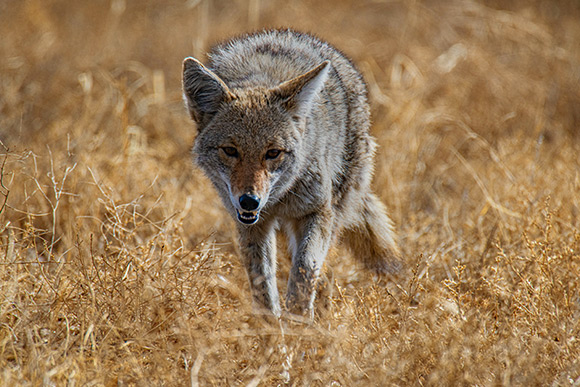
Coyote, courtesy Unsplash/mana5280
The Vermont Fish and Wildlife Department (VTFW) and the Vermont Fish and Wildlife Board are accepting public comment and will hold three public hearings on proposed new trapping and hunting coyotes with dogs regulations. The new proposed regulations come from two state legislature acts, approved in 2022:
• Act 159 directs VTFW to improve trapping safety and the welfare of animals trapped during the state’s regulated trapping seasons. The department proposes establishing a safety buffer between public roads, state-owned trails and places where traps can be set, and restricting the use of body-gripping traps to reduce the risk to pets.
• Act 165 directs the department to create rules guiding the use of dogs to hunt coyotes, a practice not currently regulated. The department proposes to cap the number of individuals permitted to hunt coyotes with dogs in Vermont to 100 and restrict the number of dogs involved in each hunt to four or fewer. Also included are safety provisions like requiring dogs wear tracking and control collars.
Public comment will be accepted through June 30, 2023. Comments can be emailed to ANR.FWPublicComment@vermont.gov with the subject line “trapping and coyote regulations.” Also, two in-person hearings and one online hearing are scheduled. In person hearings will be held June 20, 6:30-8:30 p.m., at Rutland Middle School, 67 Library Avenue, in Rutland; and June 21, 6:30-8:30 p.m., at Montpelier High School, 5 High School Drive, in Montpelier. The online hearing will be held June 22, 6:30-8:30 p.m., via Microsoft Teams at: https://tinyurl.com/trappinghearing. Following public comment, revisions by the department, and a final vote by the board, the new regulations are expected to come into effect in January of 2024.
3 Mistakes Boaters Make Using VHF Radios
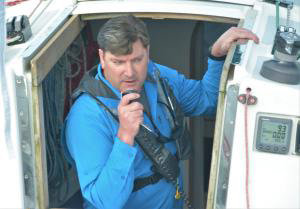
VHF radios are integral to boat safety, courtesy of BoatUS Foundation
For most recreational boaters, VHF radios are a better lifesaving tool than the omnipresent cellphone, even as more boaters use cellphones for emergency on-water communications. Why? The VHF radio remains the only tool at the boater’s disposal that can summon potential rescuers on the water nearest you – sometimes with the press of a simple red button – saving critical rescue time. To help boaters get the most out of their VHF radio, BoatUS Foundation says three mistakes boaters make when using VHF radios are:
• Failure to get a Maritime Mobile Service Identity (MMSI) number to bring your VHF into the modern age of Digital Selective Calling (DSC VHF). The MMSI number offers the ability make direct calls to other DSC-VHF radios. What an MMSI-equipped DSC-VHF radio does better than a cellphone is allow a simple, one-button mayday distress call, giving everyone aboard the ability to summon emergency help to your precise location on the water. The nine-digit MMSI number is issued for your vessel and must be programmed into your radio. You can request an MMSI for $25 at BoatUS.com/MMSI, or join BoatUS and get it for free.
• Forgetting to speak slowly and clearly. If you need to summon emergency help, remember to slow down and speak slowly, to ensure your words are understood the first time. It can save rescuers time.
• Talking on VHF radio Channel 16. VHF Ch. 16 can be a “street corner,” where you meet up with friends before heading to an activity, a night out, or fishing. After connecting, however, move on, because Ch. 16 is the place to summon emergency help. U.S. Coast Guard watchstanders monitor this channel, and since only one person may transmit on Ch. 16 at a time, routine communications with other vessels should move off this channel as quickly as possible. Hail the vessel you wish to communicate with, and when they respond, move the conversation to channels 68, 69, 71, 72 or 78A. This keeps Ch. 16 clear of non-emergency chatter.
Want to improve your VHF skills? BoatUS Foundation offers an online learning course,”All About Marine Radio,” at BoatUS.org.
North Dakota Deer Season Summary
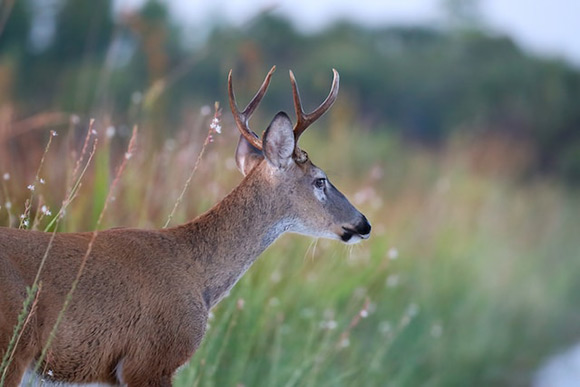
Young whitetail buck, courtesy Unsplash/Stephen Sheppard
A total of 47,590 North Dakota deer hunters harvested 25,093 deer during the 2022 deer gun hunting season, according to a post-season survey conducted by the state’s Game and Fish Department.
NDGF made 64,200 deer gun licenses available last year. Overall hunter success was 53%, with each hunter spending an average of 4.4 days in the field. “The lower success was due, in part, to deteriorating weather conditions during the beginning of the season,” said Casey Anderson, NDGF wildlife chief. “We were met with high winds immediately followed by blizzard conditions, producing measurable snow amounts and below normal temperatures for most of the season.” Hunter success for antlered whitetails was 43%, 40% for antlerless whitetails. Mule deer buck success was 64%, 70% for antlerless mule deer. A total of 1,168 muzzleloader licenses were issued, and 1,018 hunters harvested 461 whitetails (223 antlered, 238 antlerless). Hunter success was 45%. Some 27,720 archery licenses (24,414 resident, 3,306 nonresident) were issued and 22,985 bowhunters harvested 7,780 deer (6,491 whitetails, 1,289 mule deer), for a success rate of 34%. NDGF is determining recommendations for licenses in 2023. In addition to harvest rates and winter aerial surveys, NDGF staff monitor other population indices to determine license numbers, including depredation reports, hunter observations, input at advisory board meetings and comments from the public, landowners and department field staff.
Bat Report: Severe Population Decline
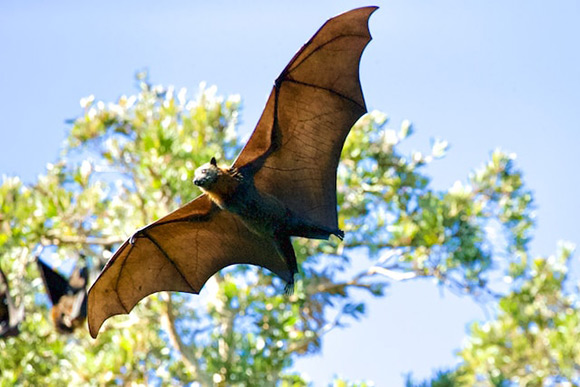
More than half of bat species at risk, courtesy Unsplash/James Wainscoat
More than half of the 154 known bat species across North America are at risk of severe population decline in the next 15 years, according to the first-ever State of the Bats Report, published by the North American Bat Conservation Alliance (NABCA), a multinational coalition from the United States, Mexico, and Canada, including Bat Conservation International. Experts believe that as many as 82% of bat species in North America will be impacted by climate change in the next 15 years, especially by severe drought and temperature extremes. The other top threats to bats include habitat loss, the white-nose syndrome disease and mortality from wind turbines. As the scope and severity of these threats increase, so does the risk of losing some species forever. “Bats are remarkable. They support our healthy ecosystems, but they need our help to survive,” said Dr. Winifred Frick, Chief Scientist at Bat Conservation International. “Conservation projects can make the difference between life or death for bats. People working together, from government agencies to bat enthusiasts, are important players to ensure bats have the attention and protections they need to survive and prosper.” The State of the Bats Report highlights the importance of bat conservation, not only for their biodiversity value, but for the ecosystem and economic services bats provide in terms of pest control, pollination, seed dispersal, ecotourism and their contributions to innovation and science. Read the full report at www.stateofthebats.org
Washington discontinues Online-Only Hunter Education
Starting June 1, the Washington Department of Fish and Wildlife (WDFW) will no longer offer fully remote hunter education courses. WDFW will continue to offer in-person hunter education courses as well as hybrid courses that combine online and in-person learning. The online courses were a great tool during the COVID-19 pandemic, said Dave Whipple, WDFW Hunter Education Section Manager, but WDFW is looking forward to shifting the emphasis back to more in-person learning. The traditional classroom course, taught over multiple evenings includes a field portion and is highly recommended. The hybrid course combines successful completion of an online course followed by a field skills evaluation where students receive hands-on training and evaluation by certified instructors. Washington requires all hunters born after Jan. 1, 1972, to complete a hunter education course to buy a hunting license. Visit https://wdfw.wa.gov/hunting/requirements/education/basic
Prevent Human-Bear Conflicts

Bear feeding on garbage, courtesy WVNDR
Nuisance bear activity in West Virginia peaks in May and June. To prevent this the West Virginia Division of Natural Resources (WVDNR) is reminding residents to secure trash and remove bear attractants from their yards. The same preventative steps should be taken while camping. “Deliberately feeding a black bear is illegal in West Virginia,” said Colin Carpenter, black bear project leader for the WVDNR. “Unintentionally feeding a bear also causes serious problems for humans, their property and our state animal. Once a bear gets used to getting food from humans, they can become a danger and often must be humanely killed." While the WVDNR starts getting reports of nuisance bear activity in April, conflicts increase and peak in May and June because high-energy foods such as serviceberries, raspberries, blackberries and blueberries aren’t available until later in the summer. “Bears that visit residential areas are less likely to stay if they don't find anything to eat,” Carpenter said. "If we all take responsibility for our property and remove or secure food attractants before bears find them, we can reduce the likelihood of human-bear conflicts." To help prevent nuisance bear activity: Never feed or approach bears. Secure food, garbage and recycling. Remove bird feeders when bears are active. Never leave pet food outdoors. Clean and store grills. Alert neighbors of bear activity. Learn more at bearwise.org.
Train to survey Monarchs and Regal Fritillary Butterflies
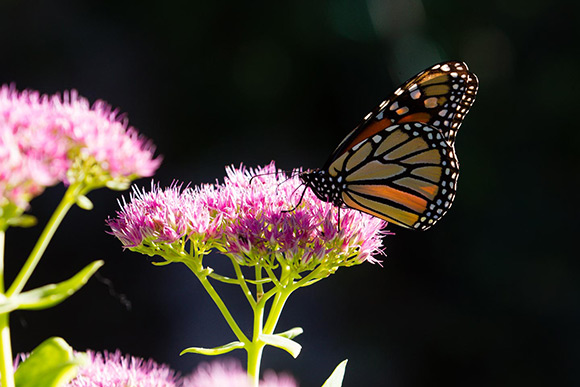
Monarch butterfly, courtesy of NGP
Want to help document rare butterflies across Nebraska? Then get trained to monitor Regal Fritillaries and Monarchs at one of two upcoming events. Anyone is welcome. Butterfly surveys will be conducted statewide between June 15 and Aug. 15 at assigned locations. Monitoring Monarch and Regal Fritillary populations of across their range began in 2015. The goal is to better understand these butterflies to provide more effective conservation. The expansive survey is not possible without the help of volunteers. The first hour of the training sessions will be dedicated to gaining general information on Monarchs, Regal Fritillaries, common plants and other community science opportunities. Those wanting to survey butterflies will learn how during the remaining time. Trainings dates: May 20, 1 - 5 p.m., at Homestead National Historical Park, 8523 NE-4, Beatrice, Nebraska; and June 3, 1 - 5 p.m. at Schramm Park State Recreation Area, 21502 W. Highway 31, Gretna, Nebraska. Register to attend one of the trainings through their event listings at Calendar.OutdoorNebraska.gov. Only one training session is required to survey for the butterflies. Those unable to attend a session, but wishing to be part of the butterfly effort can train via virtual recording on the Nebraska Game and Parks Education Youtube channel by watching all the videos in the Butterfly Survey Training playlist (https://www.youtube.com/playlist?list=PLSHsR2_eeVewVEB6Ot3NZtXvL1-V37bHj) For more information, contact Cody Dreier, survey organizer, at cody.dreier@nebraska.gov or (402) 471-1755.
Help With Missouri Breeding Bird Survey
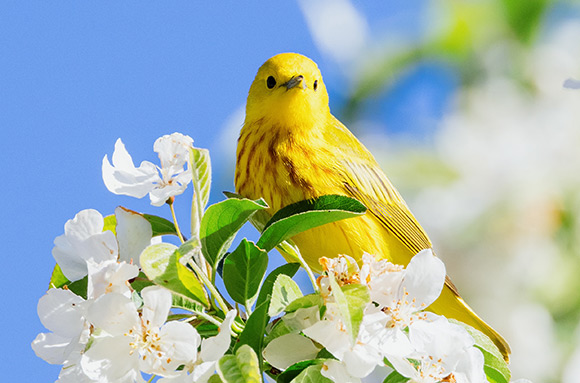
A yellow warbler, courtesy Unsplash/Mark Olsen
The Missouri Department of Conservation (MDC) needs volunteers to assist with five vacant bird observation routes in Missouri as part of the 2023 North American Breeding Bird Survey (BBS), May 27 through July 7. The five BBS routes that need volunteers are: Cassville in Barry County, Centertown in Cole County, Kenneth in Dunklin County, Sticklerville in Sullivan County, and Bland in Gasconade and Osage counties. Birders should know their birds by sight and sound. Volunteers will need to conduct their survey one day during the May 27 – July 7 survey period. BBS is a long-term, large-scale, international bird monitoring program designed to track the status and trends of North American bird populations. Each year, mostly during June, the height of the bird-breeding season, BBS volunteers collect bird population data along 24.5-mile roadside survey routes at half-mile interval stops. At each stop, volunteers conduct three-minute point counts where they record data on the bird species and numbers they see or hear within a quarter-mile radius. Surveys must start half an hour before sunrise and take about five hours to complete. Volunteers need only run their survey route once during the survey period. For more information or to volunteer, contact MDC Resource Scientist and MDC BBS Coordinator Janet Haslerig by email at Janet.Haslerig@mdc.mo.gov or call (573) 522-4115, ext. 3198. For more on the BBS, visit pwrc.usgs.gov/bbs/.
What’s coming in July?
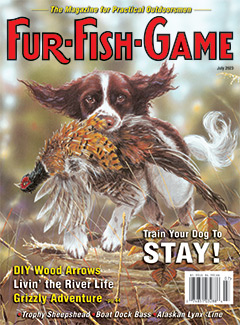
• “River Rattin’” is a truly enjoyable article from one of FUR-FISH-GAME’S regular writers, Phil Goes. Goes tells how he wanted to share his childhood’s river lifestyle with his sons, Huck and Hugo, and how he introduced them to this world. Great photos, great story.
• “Red Cap Adventures,” by Ace Sommerfeld, is a recollection of his hunts across the wild places of Alaska, Wisconsin and Montana during a formative time in his life. His red ball cap wasn’t a good luck charm, but it was always on his head as he made special memories in those locations.
• Tom Berg tells how freshwater drum saved a Great Lakes salmon fishing trip in “Having Fun With Freshwater Drum.” Berg says some anglers consider drum a nuisance, and that’s a shame.
• Lucas Byker shares his experiences with lynx in “Trapping Alaska Lynx.” The benefits of trapping lynx are clear, Byker says.
• Goes’s second story, “Training Your Dog To Stay,” share his adventure training his English cocker, Junie B, to stay on command. It will make you laugh as well as understand how to accomplish this task.
• Keith Hartman’s “Make Your Own Rain,” is a personal tale of gamebird conservation. Hartman built a water source for California valley quail, Huns, chukars and pheasants in a parched Columbia River region, where just 4-6 inches of rainfall accumulates annually.
• There’s also a new, continuing Lew and Charlie installment, with “Traplines on Big Thunder”; bass pro Glenn Walker tells you how to catch largemouths in “Boat Dock Bass”; Darren Haverstick explains the process of making your own wooden arrows in “Woodies”; Luke Clayton shares tips for striper action in “Hot Striper Action On Lake Texoma”; and 14-year-old William Carter has his second story, about a family pack trip into the Idaho mountains in “A Family Pack Trip.”
End of the Line Photo of the Month
Jess & Tim Tompkins, Finger Lakes, New York
SUBSCRIBE TO FUR-FISH-GAME Magazine

